Managing Stress in the Workplace: 9 Strategies to Support Your Employees
Last Updated Nov 7, 2025

Work moves faster than ever, causing workplace stress levels to skyrocket.
The negative impact of rising stress in the workplace extends far beyond individual wellbeing. Stress drains focus, stalls productivity, and chips away at team morale. Left unaddressed, it drives burnout, absenteeism, and turnover that hits the bottom line hard.
But it doesn’t have to be this way. When companies take stress seriously, teams can bounce back stronger. The key is creating a culture that spots the signs early, tackles root causes, and gives people real tools to lower stress at work.
Uncover the benefits of proactive stress management — and how to build a healthier, more resilient workplace.
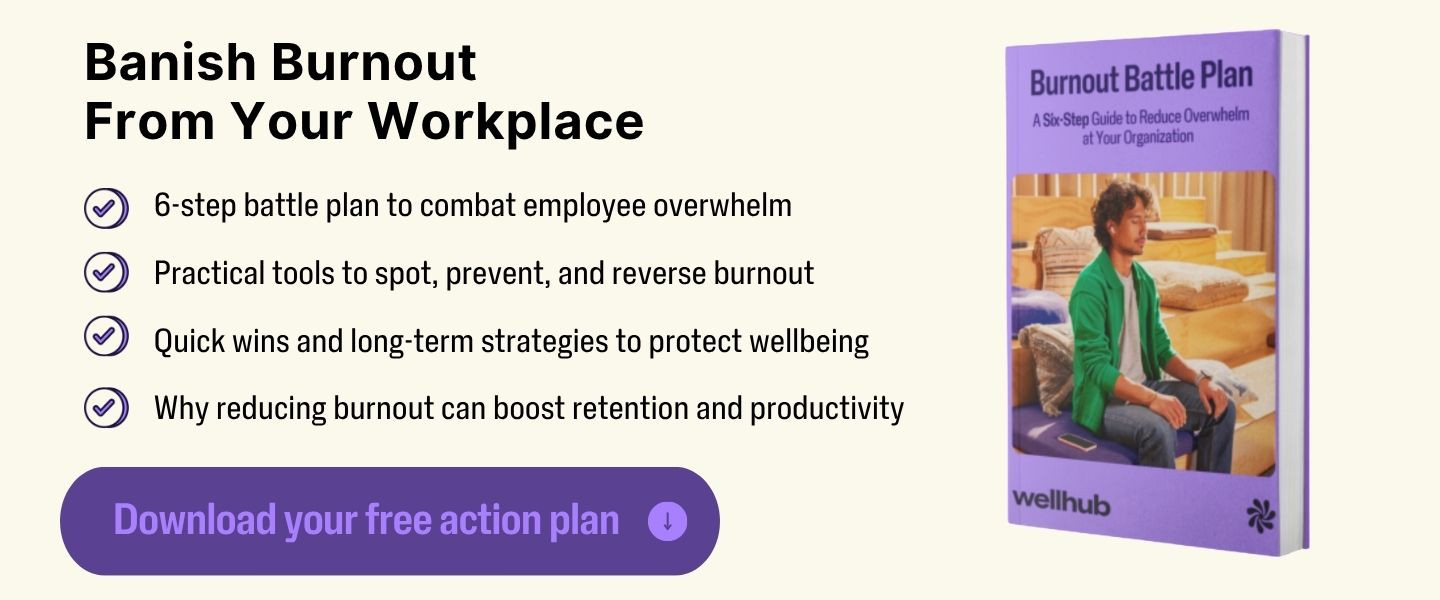
What You'll Learn
- How unmanaged stress directly impacts your bottom line through higher turnover, absenteeism, and healthcare costs.
- Why building a culture of wellbeing isn’t just good for employees — it boosts productivity, morale, and retention.
- How to spot early warning signs of burnout using real-time feedback and everyday behavioral shifts.
- Nine practical strategies HR leaders can implement today to reduce stress and promote long-term resilience.
- The importance of listening to employee feedback — and taking visible, meaningful action in response.
Why Stress Management Is Essential to a Company's Success (By the Numbers)
Workplace stress happens when job demands exceed what employees can handle. It often reveals itself in symptoms such as lower engagement, mood shifts, missed deadlines, and a spike in sick days.
When stress runs unchecked, it impacts more than just individuals’ quality of life at work. It ripples to teams and undermines business performance. Consequences include:
- Higher turnover: Burned-out employees are more than twice as likely to be actively looking for a new job.
- More absenteeism: More than half of the 550 million working days missed annually are caused by stress.
- Lower productivity and morale: Emotional wellness impacts productivity for 95% of workers, helping explain why employers report losing an average of seven hours of productivity every week due to stress, costing them $183 billion annually.
- Increased healthcare costs: Seventy-five percent of medical costs are linked to preventable conditions, many of which are stress-related.
- Legal liability and reputational damage: Burnout and disengagement don’t just hurt performance — they can erode trust and culture. When employees feel unsupported, they’re up to five times more likely to look for another job.
On the flip side, relaxed and healthy employees bring your company so much more than a positive vibe — they bring results.
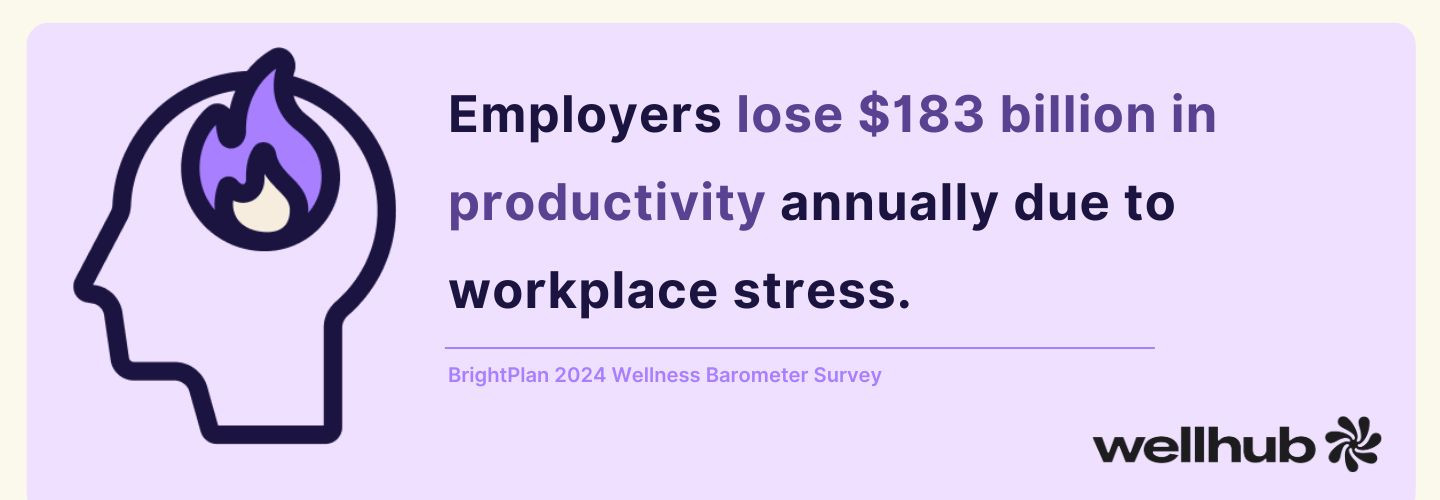
When employees feel well-supported, they’re more engaged, more present, and more productive. In fact, 97% of CEOs say their wellness programs improve productivity at least slightly, with nearly half reporting a strong impact on performance, according to Wellhub’s Return on Wellbeing 2025: The CEO Edition.
According to those CEOs, supporting wellness can also deliver:
- Higher productivity. Nearly half of CEOs say the wellness program has a strong impact on their workforce productivity.
- Better retention. Seventy-three percent of CEOs say wellbeing programs help improve talent retention.
- Reduced absenteeism. Two-thirds of CEOs say wellness programs significantly reduce missed workdays.
- Lower healthcare costs. Sixty-eight percent of CEOs report their wellness initiatives help reduce healthcare expenses.
- Improved morale. More than half of CEOs say they invest in wellness programs specifically to boost engagement and morale.
- Stronger employer brand. Eight out of 10 CEOs say their wellness program enhances talent attraction, with 42% calling it extremely impactful.
The takeaway here? Reducing stress isn’t just about feeling better — it’s a performance strategy. Employees thrive when you create the conditions for wellness at work. And when your people thrive, your business does too.
How To Know if Your Organization Is Suffering from High Levels of Work-Related Stress
Workplace stress is sneaky. It rarely kicks down the door — instead, it creeps in quietly and compounds over time. And while one tough week might not spell trouble, persistent signs can point to a deeper, systemic issue.
Here are common stress signals that deserve your attention:
- Frequent absences or tardiness. Repeated sick days, stress leave, or late arrivals can signal burnout or avoidance — not just the flu.
- Low energy or disengagement. If once-active employees go quiet in meetings or disengage from projects, it’s time to check in.
- Irritability or tension. Rising conflict or mood shifts between team members can be emotional spillover from chronic stress.
- Drop in performance. A spike in mistakes, missed deadlines, or slowed output isn’t always a performance issue — it’s often a wellbeing issue.
- Increased reliance on health benefits. Higher utilization of mental health or medical services may reflect a stressed and struggling workforce.
These aren’t isolated moments. They’re patterns — red flags waving from your employee experience data. Left unaddressed, they lead to long-term fallout, including turnover, absenteeism, and disengagement.
So what can you do?
To manage stress effectively, organizations need more than reactive fixes. You need embedded systems that identify, address, and prevent burnout at scale.
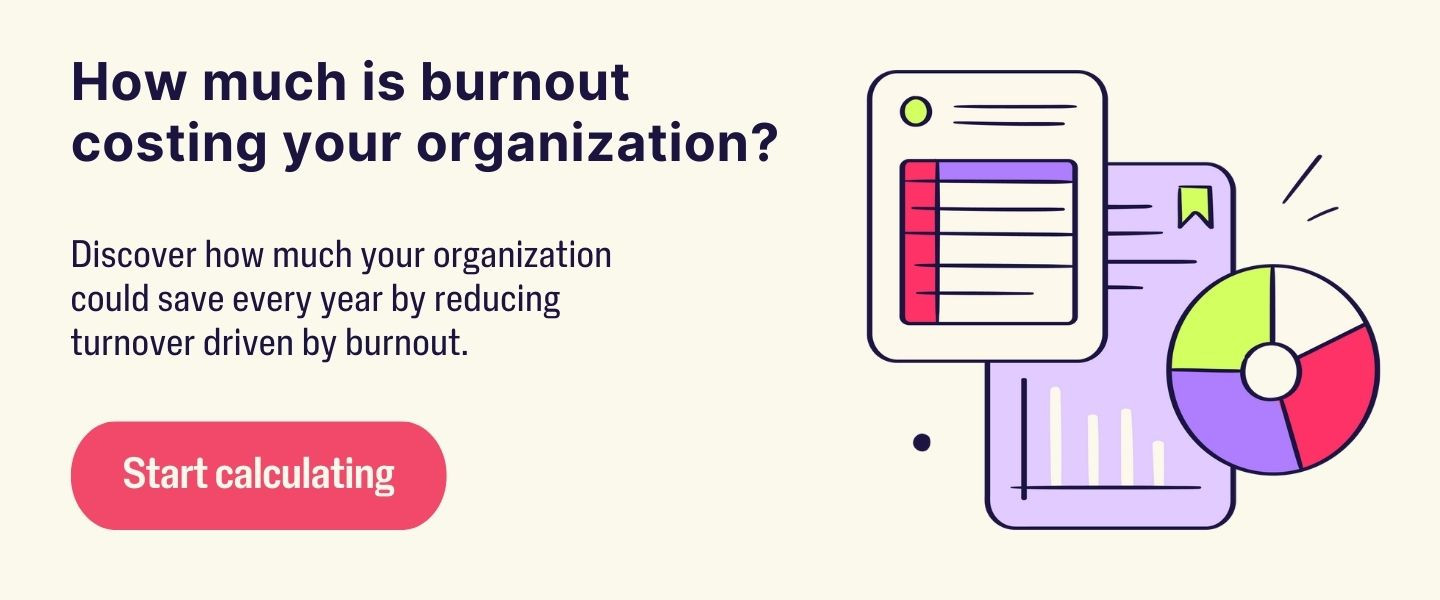
Here’s where to start:
- Quantify the cost of burnout. Understand how stress is impacting your people — and your bottom line. Metrics like turnover rates, absenteeism, and engagement scores help you make a business case.
- Leverage pulse surveys and real-time feedback. Don’t wait for an annual engagement survey. Frequent check-ins give you a clearer, quicker view of how your team is doing.
- Train your managers as frontline stress responders. Managers are often the first to notice something’s off. Equip them with tools to recognize burnout and respond with clarity and care — not just productivity pressure.
- Integrate stress management into existing HR strategies. Wellness shouldn’t live in a silo. Tie stress reduction to performance goals, DEI initiatives, and learning and development. When wellness is part of the big picture, it becomes everyone’s priority.
- Reevaluate your policies. Do your workloads, time-off policies, and expectations around availability support emotional resilience — or sabotage it? Policies should enable people to thrive, not just survive.
Change doesn’t happen overnight. But when HR leaders make stress management a core part of how their organization operates — not just a perk — they send a powerful message: You can do your best work here without burning out.
Spot the signs of stress before they spiral. Discover the key symptoms and their solutions.
9 Proven Strategies for Managing Stress in the Workplace
Managing stress requires building systems that help your people thrive. These nine strategies are practical, adaptable, and designed to meet your team where they are. Use them as a springboard to create a culture that supports wellbeing at every level.
- Encourage Open Communication About Mental Wellbeing
Let’s be real: mental wellbeing still feels off-limits at work for a lot of people. And that silence? It costs more than you might think.
According toMind Share Partners, fewer than 40% of employees say their company prioritizes mental health, and only half feel supported at all. When employees don’t feel safe to speak up, stress doesn’t disappear — it just goes underground.
So how do you make openness the norm, not the exception?
Start at the top. When leaders talk honestly about stress or share how they manage tough days, they send a clear signal: it’s okay to be human here. That vulnerability opens the door for everyone else.
Then, build intentional moments into your culture:
- Add space for emotional check-ins during one-on-ones.
- Create anonymous channels for feedback and support.
- Encourage peer-led groups or Slack spaces where employees can share wellness resources and tips.
And don’t underestimate the power of simple questions like:
“How are you really doing?”
“What’s one thing that would make work easier this week?”
The key? Follow through. When honesty leads to meaningful action, trust grows. And trust is the foundation of a work culture where wellbeing isn’t just supported — it’s expected.
- Promote Work-Life Wellness by Setting (and Living) Smart Boundaries
In today’s always-on world, shutting off is harder than ever. And the rise of remote work hasn’t helped. Nearly 70% of remote workers say they’re more burned out because of nonstop digital communication, according to Forbes.
That’s where boundaries come in — not just as policies, but as cultural norms.
Encourage your leaders to:
- Delay sending emails until business hours.
- Block out “no meeting” time for deep focus.
- Take — and truly unplug during — PTO.
The message should be loud and clear: Rest is productive. Logging off is encouraged. And burnout is not a badge of honor.
Most importantly, make sure these norms apply to everyone — from interns to executives. When leadership models these boundaries, it gives your entire team permission to protect their wellbeing without guilt.
Supporting work-life wellness isn’t just about policies. It’s about creating an environment where people can show up fully — and then actually go home.
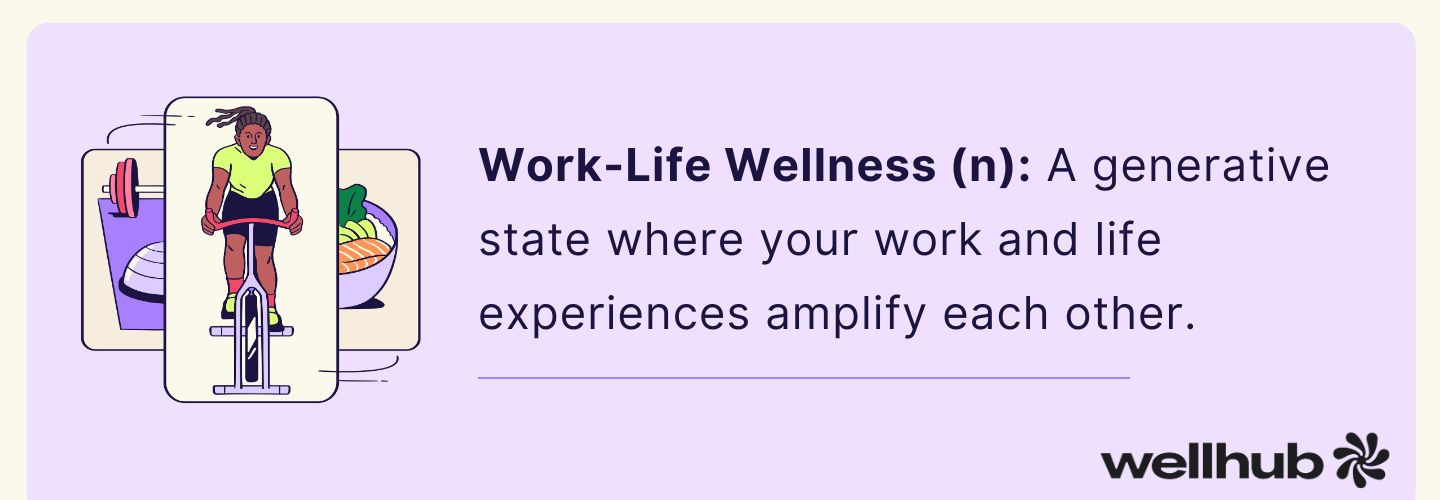
- Offer Flexible Scheduling or Remote Work Options
Flexibility isn’t just a pandemic-era perk anymore. It’s now a top driver of employee satisfaction. One of the biggest benefits of remote and hybrid work? Flexible hours, according to Forbes. And for many employees, that flexibility directly impacts their wellbeing.
The good news? You don’t need to reinvent your org chart to offer it.
Start by giving employees more control over how and when they work. That might mean:
- Offering remote or hybrid schedules.
- Letting people flex their hours to match personal needs or time zones.
- Allowing compressed workweeks or mid-day breaks to recharge.
Even small shifts — like starting earlier to finish earlier or extending lunch for a workout — can make a real difference. When people have more autonomy, they feel more trusted. And when they feel trusted, they’re more focused, more loyal, and less stressed.
The takeaway? Flexibility isn’t a trend. It’s a wellbeing strategy — and it pays off.
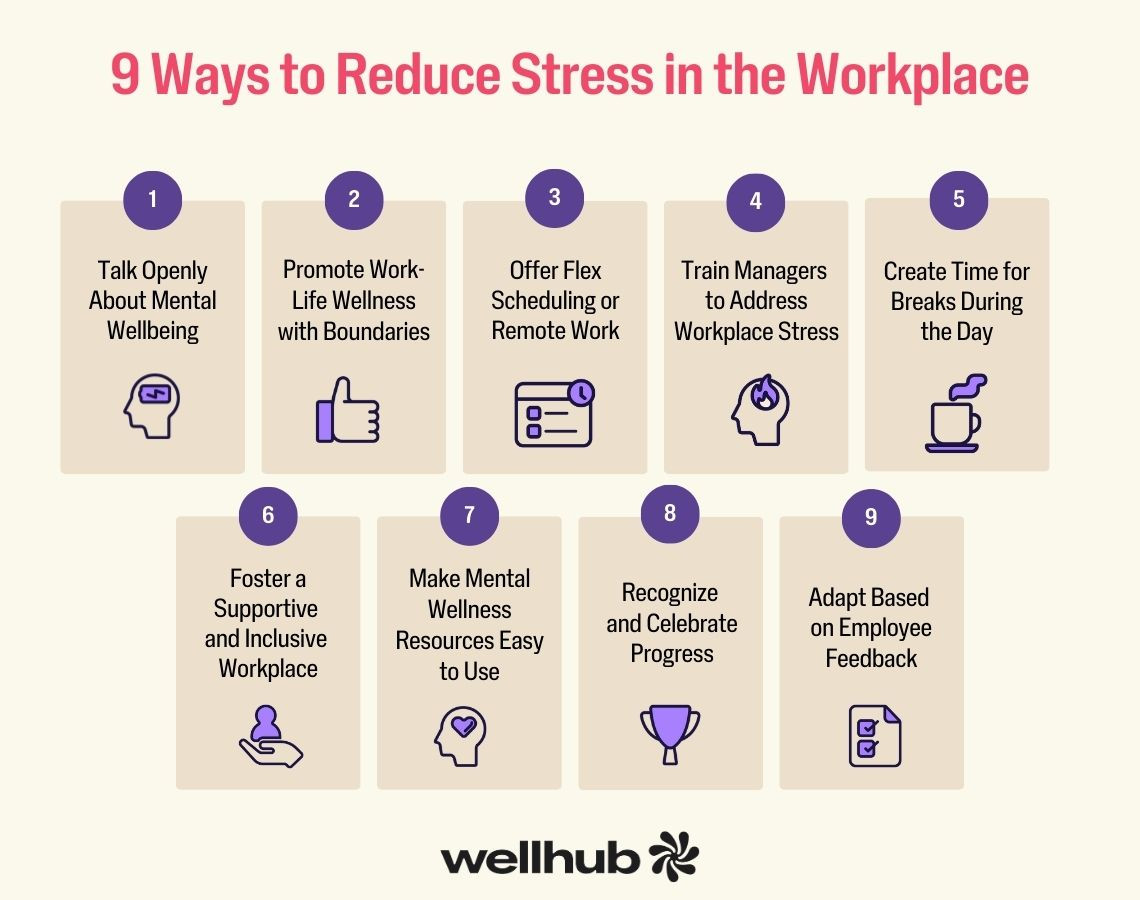
- Train Managers To Recognize and Respond To Stress
Your managers are your first line of defense against burnout. But most aren’t trained to spot the signs, let alone address them with confidence: One in three managers feel out of their depth when it comes to mental health — and that number jumps to 45% for younger managers.
That’s a gap worth closing.
Here’s how to set your managers up for success:
- Offer empathy and emotional intelligence training. Help them navigate sensitive conversations with care.
- Create simple scripts and playbooks. Make it easier to say the right thing — especially when tensions are high.
- Practice with real-world scenarios. Roleplaying builds confidence, so managers feel ready before a real issue arises.
When managers know what to look for — like sudden silence, irritability, absenteeism, or changes in communication — they can step in with support before stress spirals.
Supporting your managers means they can better support their teams. And that ripple effect? It’s how you build a culture of care that lasts.
- Create Opportunities for Regular Breaks and Downtime
Skipping lunch might look productive on the surface — but over time, it drains focus, creativity, and resilience. The truth is, your brain isn’t designed to operate at full speed all day long.
Research suggests the sweet spot is 52 minutes of work followed by a 17-minute break. Yet many employees still feel guilty stepping away, even for five minutes.
Let’s change that.
Encourage your team to:
- Take screen-free lunches that actually feel like a pause.
- Replace back-to-back meetings with 25- or 50-minute sessions.
- Opt for walking meetings when a laptop isn’t necessary.
Want to take it a step further?
Add gentle stretch reminders into calendars. Introduce “wellness hour” blocks for mid-week resets. When you protect downtime, people don’t just come back refreshed — they come back with perspective.
And that’s when great work happens.
Want to stop stress at its source?Find out what causes workplace stress and how to manage it.
- Design Supportive and Inclusive Work Environments
Stress thrives in environments where people feel invisible, excluded, or overlooked — even if the benefits package is solid. Culture matters. And when it’s inclusive and kind? People thrive.
Here’s how to create a work environment that reduces stress by design:
- Support physical comfort. Offer ergonomic setups or stipends for home office upgrades.
- Honor diverse identities. Celebrate cultural holidays and acknowledge different life experiences in your programming.
- Rethink social events. Instead of pressure-filled team bonding, offer opt-in activities like book clubs, wellness walks, or themed lunches.
- Integrate wellbeing into everyday life. Think gym memberships, digital fitness classes, or guided meditation during the workday.
When employees feel safe and seen, their stress levels drop — and their potential skyrockets.
- Make Mental Health Resources Easy to Find — and Easy to Use
You don’t need to build a wellness center in your lobby to support your team’s mental wellbeing. But you do need to make sure your resources aren’t hidden behind three logins and an outdated intranet page.
The key? Visibility and ease of access.
Here’s how to bring mental health support into the everyday:
- Highlight resources early and often. Don’t just mention your EAP during onboarding — revisit it during all-hands and manager meetings.
- Offer monthly wellness stipends. Let employees choose what works for them — therapy, fitness, mindfulness apps, or even massage.
- Create a centralized resource hub. Use Slack, Notion, or your HRIS to list top tools, stress-relief tips, breathing exercises, and upcoming wellness events.
- Partner with wellness providers. Host drop-in meditations, expert webinars, or live Q&As that your team can easily access without pre-work or prep.
The more visible and customizable your support is, the more likely your team is to actually use it.
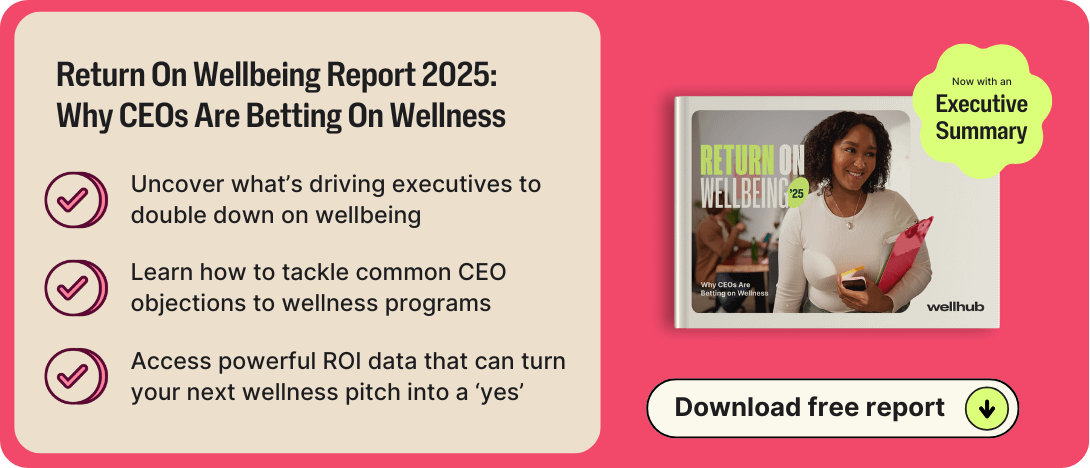
- Recognize Effort and Celebrate Progress Regularly
When people feel recognized, they’re more resilient. Recognition fuels motivation — especially when work gets tough.
You don’t need a formal awards ceremony. A few thoughtful habits go a long way:
- Shout out wins in standups and team channels.
- Send a handwritten note or Slack kudos on work anniversaries or personal milestones.
- Use peer-to-peer shoutout systems that let coworkers recognize each other in real time.
And don’t forget the little things. A simple “thank you for jumping in so quickly” can lower someone’s stress by reminding them that their work matters — and they matter, too.
- Evaluate and Adapt Policies Based on Employee Feedback
You can’t manage what you don’t measure. That’s why stress management strategies only work when they’re grounded in real employee feedback.
To make that happen:
- Run quarterly surveys focused specifically on stress, workload, and wellbeing.
- Host Ask-Me-Anything sessions with leadership to surface issues and show transparency.
- Send one-question pulse polls to track shifting needs over time.
But here’s the most important part: do something with the data.
If employees say meetings are overwhelming, pilot a no-meeting Friday. If feedback shows people are feeling disconnected, explore new community-building rituals.
Saying “we hear you” is just the beginning. When you follow through, you turn trust into action — and action into lasting culture change.
Tackling Workplace Stress Starts With Wellbeing
Stress at work doesn’t just wear people down — it drags performance down with it. When employees face constant pressure, burnout rises, absenteeism climbs, and turnover costs hit hard. HR teams feel the ripple effects daily: lower engagement, tense teams, and rising healthcare claims.
An employee wellbeing program helps stop stress before it snowballs. It gives employees tools to recharge, set boundaries, and take care of themselves. The impact goes far beyond stress relief. Companies that offer Wellhub are see up to 40% less turnover and can cut healthcare costs by up to a third.
Speak with a Wellhub Wellbeing Specialist to reduce burnout, boost morale, and build a more resilient team.

Company healthcare costs drop by up to 35% with Wellhub*
See how we can help you reduce your healthcare spending.
[*] Based on proprietary research comparing healthcare costs of active Wellhub users to non-users.
Category
Share

The Wellhub Editorial Team empowers HR leaders to support worker wellbeing. Our original research, trend analyses, and helpful how-tos provide the tools they need to improve workforce wellness in today's fast-shifting professional landscape.
Subscribe
Our weekly newsletter is your source of education and inspiration to help you create a corporate wellness program that actually matters.
Subscribe
Our weekly newsletter is your source of education and inspiration to help you create a corporate wellness program that actually matters.
You May Also Like

FSA vs. HSA Strategy for HR Leaders | Wellhub
Compare FSA vs HSA rules, tax advantages, eligibility, and rollover differences to help employees choose the right account and avoid costly compliance issues.

Employee Wellness Programs: Key Components for Success | Wellhub
Transform your workplace wellness strategy by integrating physical, mental, financial, and social wellbeing into a comprehensive wellness program that works

Benefits Strategy Roadmap: Pull and Retain Top Talent | Wellhub
Support wellbeing, reduce turnover, and maximize ROI with a benefits strategy built for today’s workforce—not yesterday’s spreadsheet.